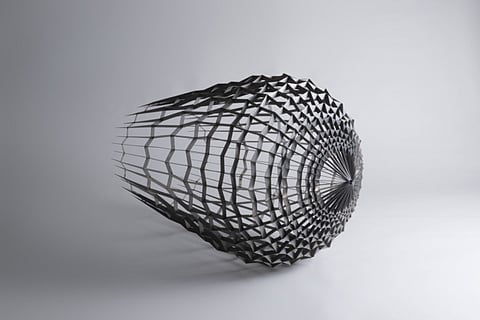‘Khalvat’ reveals hidden layers
The Iranian sculptor’s body of work explores the relationship between Iranian architecture and its metaphysical symbolism

Sahand Hesamiyan takes inspiration from Islamic architecture to create sculptures that present ancient concepts of transcendence in a contemporary context. In his latest body of work, “Khalvat”, the Iranian sculptor continues his exploration of the relationship between Iranian architecture and its metaphysical symbolism. The centrepiece of the show is a massive white, steel sculpture that looks like a dome, lying on its side on the floor. As viewers walk around it, they see that the lower portion is an elongated projectile like structure, also covered with the same traditional “Rasmi” style triangular pattern as the dome. But surprisingly, the other end of this solid imposing structure is hollow, offering a view of the complex architectural layers and ornamental details inside. Light filtering in from the outside and the sky like effect of the star-shaped decoration creates the effect of a beautiful universe inside.
Other works in the show include digital prints on paper, silk screen prints, paper maquettes, and smaller steel prototypes revealing the skeletal structure and different layers of the large sculpture. “Khalvat” is the Persian word for a hidden, private sanctum. The artist’s choice of this title refers to the fact that in this body of work, he has tried to dissect traditional architectural forms and the framework of Iranian culture itself, peeling off the external layers in a quest to discover the spiritual core within.
“The inspiration for this work comes from traditional Iranian houses that are built with different layers of privacy. Most visitors are received in the outer rooms; but as you get closer to the family, you will get access to inner sanctums. I wanted to reveal the layers in our architecture and in our culture through my sculpture. So, when visitors enter the gallery they see a solid, conical shape. But when they go around to the other side they will find a whole new universe inside.
The shape and external look of the sculpture is directly inspired by the triangular “Rasmi” style decoration seen above the windows in traditional houses in Yazd and other areas in Iran. The star studded interior is based on the Yazdi Bandi style of decoration, seen in domes of mosques, bazaars and other structures. The details of these intricate, layered designs can be seen in Hesamiyan’s digital prints, paper maquettes and steel prototypes. A layer of tracing paper on the prints also conveys the idea of two different worlds. The artist has also created some three-dimensional wall-mounted pieces that capture the beauty, meditative quality and play of light and shadow in the repeated triangular “Rasmi” pattern.
“My work is site specific. The size of this sculpture was dictated by the space available in the gallery. It had to be really big to create a powerful effect on viewers. I decided to place it on its side to evoke a sense of tranquillity and relaxation. I have also carefully chosen a piece of music to be played in the gallery during this show that conveys a peaceful, meditative feel” the artist says.
Hesamiyan’s sculpture is inspired by Islamic architecture, which reflects the metaphysical order that governs the cosmos and the absolute, boundless and timeless nature of god. In the complex design of the dome, the circle at the focal point represents unity; and the inner engineering establishes an interior within an interior where the atmosphere is vertically defined. And the starburst ceiling is a three-dimensional representation of infinite creation.
In this context, the artist’s interpretation of the dome can be seen as a reference to the Sufi quest for purification through annihilation of the ego to reach an enlightened state. He has stripped away the complex layers to uncover the inner mystic core or “unity of being”. The skeleton of concentric rings held in place with ribs that meet at the apex suggest different stages of ascension in the pursuit of truth; and the light filtering in signifies a divine presence. The work also explores the history of Iranian architecture, and its impact on the structure of public and private spaces and on social interaction.
“Seeing the houses with not so easily accessible inner sanctums made me think of the external self and the spiritual core or soul that exists within all of us. My aim was to show viewers the difference in viewing something or someone from outside and inside. The outside of this sculpture is hard and tough. But inside there exists a different universe. The concepts of unity, infinity, transcendence and absolute truth are inherent in Islamic architecture. But all I want to do is show the viewers two different worlds, an inner and outer one; and it is up to them to interpret it in their own way,” the artist says.
“Khalvat” will run at The Third Line until December 24
Sign up for the Daily Briefing
Get the latest news and updates straight to your inbox



